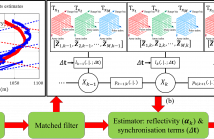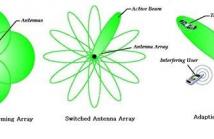
- Read more about A DEEP NEURAL NETWORK BASED METHOD OF SOURCE LOCALIZATION IN A SHALLOWWATER ENVIRONMENT
- Log in to post comments
- Categories:
 23 Views
23 Views
- Read more about Virtual Pulse Design for IEEE 802.11ad-Based Joint Communication-Radar
- Log in to post comments
The millimeter wave WLAN standard can be used for joint communication-radar by exploiting the waveform preamble as a radar pulse. The velocity estimation accuracy with this approach, however, is limited due to the short integration time. A physical increase in the radar pulse integration duration, however, leads to a decrease in the communication data rate.
- Categories:
 28 Views
28 Views
- Read more about JOINTLY TRACKING AND SEPARATING SPEECH SOURCES USING MULTIPLE FEATURES AND THE GENERALIZED LABELED MULTI-BERNOULLI FRAMEWORK
- 2 comments
- Log in to post comments
- Categories:
 3 Views
3 Views- Read more about Joint Estimation of the Room Geometry and Modes with Compressed Sensing
- Log in to post comments
Acoustical behavior of a room for a given position of microphone and sound source is usually described using the room impulse response. If we rely on the standard uniform sampling, the estimation of room impulse response for arbitrary positions in the room requires a large number of measurements. In order to lower the required sampling rate, some solutions have emerged that exploit the sparse representation of the room wavefield in the terms of plane waves in the low-frequency domain. The plane wave representation has a simple form in rectangular rooms.
- Categories:
 19 Views
19 Views
- Read more about OPPORTUNISTIC SYNCHRONISATION OF MULTI-STATIC STARING ARRAY RADARS VIA TRACK-BEFORE-DETECT
- Log in to post comments
In this work, we consider the problem of synchronising separately located transmitters and a staring array receiver that also has a local transmitter. The acknowledged benefits of using separate transmitters in active sensing are often undermined by the difficulty in accurate synchronisation of the receiver and the transmitters. In this work, we propose a solution that is based on measurements from non-cooperative objects in the illuminated region. We formulate the problem as parameter estimation in a state space model with individual transmitter channel data cubes as measurements.
- Categories:
 39 Views
39 Views
- Read more about MEMORY-ASSISTED SEISMIC SIGNAL COMPRESSION BASED ON DICTIONARY LEARNING AND SPARSE CODING
- Log in to post comments
Seismic traces recorded in a single sensor from multiple shots demonstrate significant correlation. We propose a memory-assisted seismic signal compression method based on dictionary learning and sparse coding that would explore this correlation. Different from traditional methods, the dictionary used for compression is learned and updated by the information extracted from the common memory between the sender (sensor) node and the receiver node, over a fixed window of the most recent traces. The common memory is formed by the previously transmitted traces.
- Categories:
 4 Views
4 Views
- Read more about Distributionally Robust Chance-Constrained Minimum Variance Beamforming
- Log in to post comments
This paper studies distributionally robust chance-constrained minimum variance beamforming. In contrast to deterministic modeling of the steering vector, our approach models the uncertainty statistically via distributions. We select the weights that minimize the combined output power subject to the distributionally robust chance constraint that for all distributions in the uncertainty set, the gain should exceed unity with high probability.
Slides.pdf
- Categories:
 11 Views
11 Views- Read more about Imaging in Radio Interferometry by Iterative Subset Scanning Using a Modified AMP Algorithm
- Log in to post comments
Imaging techniques in radio interferometry often face a significant challenge posed by the large number of antenna signals received, from which the image information needs to be extracted. Beamforming is envisaged to reduce the rate required for transporting data from groups of antennas to a central site for further processing. We propose a novel method for image reconstruction based on the iterative scanning of a region of interest, combined with randomized beamforming. A modified approximate message-passing algorithm
- Categories:
 14 Views
14 Views- Read more about Waveform Encoding for Nonlinear Electromagnetic Tomographic Imaging
- Log in to post comments
In this talk, we present a new time domain electromagnetic tomographic imaging algorithm using coded
multiple excitation signals to reconstruct an extended object immersed in inhomogeneous medium. Three waveform encoding
techniques are developed to enable simultaneous source excitation as a way of improving computational efficiency
- Categories:
 6 Views
6 ViewsPages
- « first
- ‹ previous
- 1
- 2
- 3
- 4